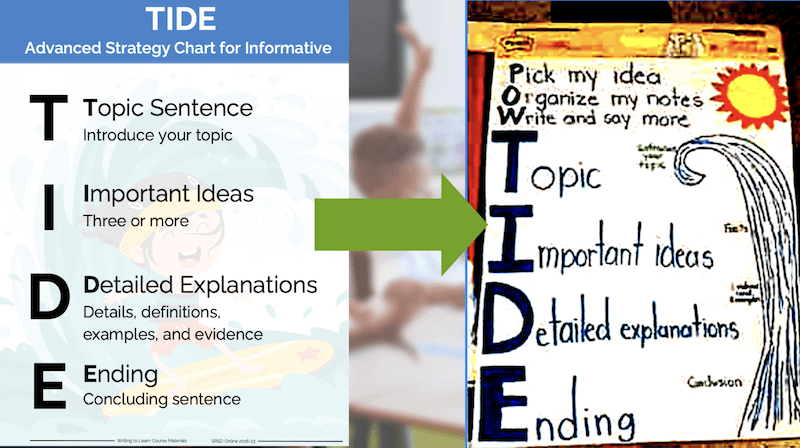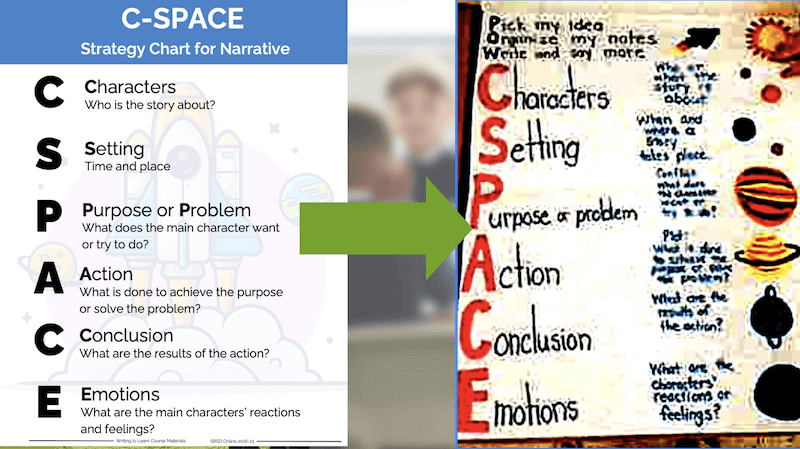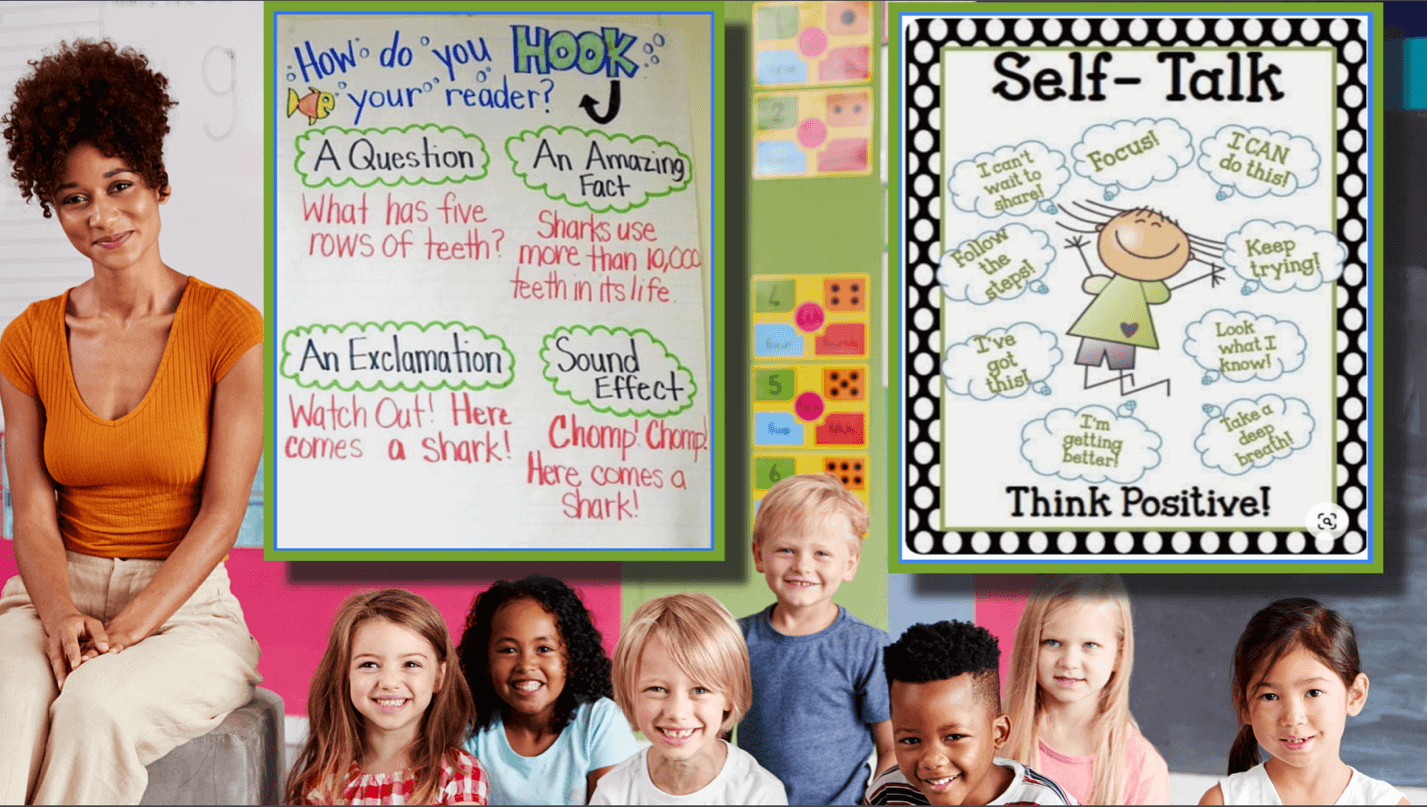SRSD In Action: The Science of Writing
Observing SRSD in the classroom starts with its secret sauce: positive self-talk and thinking aloud during teacher modeling. When teachers verbalize their thoughts, struggles, and strategies while demonstrating writing tasks, they make invisible thought processes visible and relatable. This allows students to see how experienced writers handle each step because they get to see inside your head. By incorporating positive self-talk, students learn to build confidence and motivate themselves to become effective writers.
SRSD In Action - Students and Teachers In the Classroom!
Students are so excited about SRSD because it provides writing strategies for students that are more enjoyable and that boost their confidence. Students appreciate how their teacher models the writing process, making it easier to understand, and they enjoy the independence of using organizers to check their work. SRSD helps them feel more capable and allows them to progress at their own pace. See SRSD in action in this video.
There are countless ways to model this with students—here’s how one teacher does it!

"My students absolutely loved using the mnemonics! We even added little motions to go along with them, and the kids really got into it. It worked so well—it was fabulous to see them using the strategies so effectively!"
SRSD In Action: Modeling Daily Memorization
In SRSD classroom implementation, memorization activities before and after each lesson help students internalize the writing strategies and make the process mentally easier. This repetition not only reinforces the strategies, making their use more automatic but also facilitates the transfer of skills to different subjects and contexts, leading to improved writing skills and overall academic success.
There are countless ways to model this with students—here’s how one teacher does it!

"Memorization is key for building strong writing habits and removing cognition load, so I model it before and after every lesson. I have a lot of fun with it, but I think the kids like it even more!"
SRSD In Action
Modeling Grade 2
This engaging video showcases a second-grade teacher modeling the SRSD approach to finding evidence in an informational text about pigs. She guides students through re-reading and annotating the text, teaching them to identify important details that answer the prompt “Explain what makes pigs interesting.” By incorporating interactive discussions and encouraging critical thinking, she makes the learning process practical and enjoyable.
"Watching my students during these lessons has been incredible. They started to really differentiate between what's important and what's not, instead of trying to include everything. It's amazing to see how SRSD is helping them become more focused and confident in their reading and writing."
Stephanie Racicot
Second-grade teacher, Northbridge MA
SRSD In Action: Making It Personal!
In real classroom settings, students thrive when they can personalize the formal strategies and charts provided to them. By creating their own versions of these tools, they not only deepen their understanding but also find the learning process more engaging. For example, a class might develop their own charts on “hooks” to brainstorm captivating opening sentences or on “self-talk” to encourage positive thinking during writing tasks. This hands-on involvement empowers students to grasp the strategies more effectively and fosters an interactive and collaborative classroom atmosphere.
SRSD In Action
Modeling Grade 5
This video features a fifth-grade teacher demonstrating how to guide students in identifying the parts of an essay, engaging in self-assessment, and using color coding. By modeling the process while thinking aloud, he shows students what overcoming the obstacles looks like so they can honestly evaluate their work step by step. The use of color-coded highlighters to mark different parts of the writing—such as hooks, reasons, and explanations—provides a practical and engaging strategy that you can adopt in your own classroom.
"This has been really unbelievable. By modeling using my own writing and letting my fifth graders get into my mind, I've seen them finally understand how writing works. It's incredible how this lets them take ownership of their writing.”
Bob McLaughlin
Fifth-grade teacher, Northbridge MA
"We love seeing the consistency in the writing as students move from third to fourth to fifth grade. We’re incredibly proud of the work our teachers are dedicating to SRSD implementation, and it’s amazing to see students thriving under their instruction! Great things are happening here in Hamblen County!"
Michelle Morgan
Hamblen County, TN
SRSD In Action: A “No-Fail” Environment
Many teachers struggle to see how SRSD strategies evolve from one grade to the next. This informative video offers a clear roadmap for progressing students as they acquire new SRSD writing skills. You'll learn how to adapt mnemonics like TREE to suit differentiated groups within your classroom and even as students move to higher grades, ensuring that writing instruction is practical and developmentally appropriate. The video demonstrates how to meet your classroorom engaging kindergarteners with basic opinions to guiding secondary students through complex argumentative essays with counterarguments and rebuttals. By watching, you'll gain valuable insights on systematically reinforcing previously taught concepts while introducing new ones, making writing instruction more impactful at every stage.
There are countless ways to model this with students—here’s how one teacher does it!

"SRSD has totally changed our classrooms. By building up skills step by step and reinforcing what they've already learned, our students have become so much more confident and know they won't fail along the way. It's awesome to see them succeed and grow with each new writing skill they pick up."
SRSD In Action: Making it Meaningful and Memorable
An essential component of the SRSD method is encouraging teachers and students to collaboratively redesign strategy charts and display them prominently in the classroom. This creative process makes SRSD’s writing strategies for students more meaningful and memorable, providing a constant visual aid that supports students during writing activities. By customizing these charts, students become more invested in their learning, enhancing their grasp of writing techniques and self-regulation skills. Displaying these personalized tools helps accommodate diverse learning needs and contributes to a supportive classroom environment where strategies are accessible to all.
“Can I bring it home when we are done? I want to hang it up in my room!” – 4th grade student
Here are three examples of classroom interpretations:
TREE

TIDE

C-SPACE

"Our third-grade students are now second in the county on their MSTEP scores and rank quite high across the state. Having a solid, consistent format like SRSD gives students something to rely on and feel safe with. It removes the heavy lifting that comes with writing, allowing them to focus on getting their ideas on paper. That's the power of SRSD writing."













